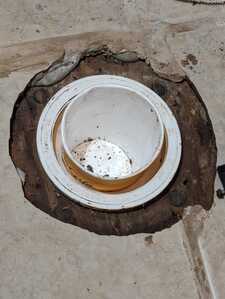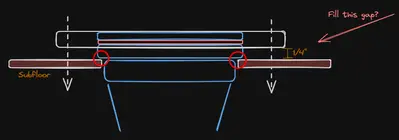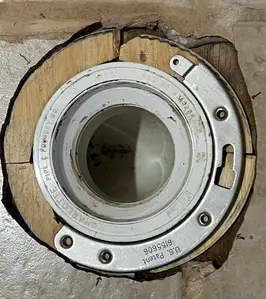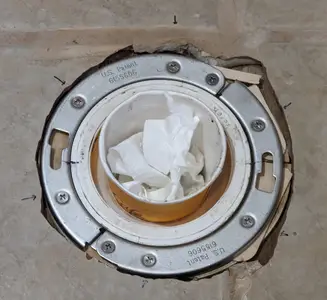Hi, I pulled away a toilet and the PVC flange's metal ring was rusted away. At this point only the central PVC 'hub' (not sure if that's the right term) of the flange remains.
I ultimately want to reinstall the toilet with a Danco Perfect Seal from the All-in-One kit, but I'm not sure the best option of getting the flange back to a normal state. (The subfloor seems strong enough so thankfully I don't think any floor repair will be needed.)
The Oatey 1-piece stainless ring looks like the simplest solution, but I'm not sure if the PVC hub needs to be supported by the (metal) ring from underneath. I am guessing that is the whole point of the split rings they also offer, so you can slip them under the hub, but those only come in galvanized and not stainless or brass.
Aside from cutting away the whole existing PVC flange and replacing that (which is obviously a lot more work), do I have any good options besides the above two for getting a new flange ring here?
If the ring only needs to fasten that hub down to the subfloor, the 1-piece ring should work. But if I need to get the ring underneath the outer lip of the hub, it seems like I have no choice but to use the split ring? I guess I'm not sure if the metal ring is responsible for holding the pipe down, or up, or both.
Here is what the situation looks like:
May have found a solution.
https://www.theclamflange.com/installation-guide?lightbox=dataItem-lpve322e
After reading the instructions for this product, I'm realizing I was thinking of this wrong -- the lip on the inside of the split-style ring replacements fits into the slot on the head of the old flange where the original ring was, and not just underneath the flange. So any of these split rings I think should be able to completely immobilize the PVC head relative to the floor.
That said, I feel like the Oatey style, which creates a raised 'hump' at the closet bolt slots, would leave a gap under a Perfect Seal, wax ring or any other type of seal. The design makes no sense to me. On the other hand 'The Clam' model will leave a flat surface on which to mount your seal, so this seems superior to me.
In my case I will probably create a circle of wood to go under the new metal ring as a riser to maintain the original pipe slope. If you look carefully at my pic there are 4 dark circles; the previous install had 4 copper caps jammed underneath the ring to raise the flange up by about 1/2", I'm concerned that just replacing the ring by itself will leave me with a reduced slope.
Hey @Thesis3522 sorry for the delay. Did you get it fixed? I had good luck with this Oatey repair flange in the past for this type of fix https://www.acehardware.com/departments/plumbing/parts-and-repair/flanges/4013848?store=10282&gad_source=1&gclid=CjwKCAjwi_exBhA8EiwA_kU1MuLuybHEaDc7bPEpd88XN79pZE0_pZ9rPoWX2fjuLH5LnBpset-ZQhoCgSoQAvD_BwE&gclsrc=aw.ds
Thank you Scott for checking in. I did manage to get it fixed, I ended up using the 'Clam' one from the link above -- it fit the bill perfectly.
The situation was such that, I wasn't sure if I was comfortable using something that just fit over the top of the remaining PVC portion of the flange -- which would provide support from above, but not from below -- since I had zero remainder of the original ring. The head of the PVC was basically just sitting on the outer edge of the subfloor hole that was cut out for it, hopefully this diagram helps make sense of it:
So I was hoping to find something that would immobilize the flange in both upward and downward directions. This meant I needed to either get something under it, or in this case, 'into' it using the slot that held the original ring and putting a new ring in its place.
To fill that gap I bought a couple cheap hole saws and a small sheet of 1/4" thick plywood and cut out a 'donut' of wood. After cutting it into quarters, and doing a little trimming, I was able to build up to fill that gap.
Sadly there was a bit of slope to the subfloor (perhaps from getting wet) so I still ended up with about another 1/16" of vertical wiggle on the right-hand side. I used a couple pieces of popsicle sticks and tongue depressors to tighten up the remaining space.
Screwed the flange ring through the whole shebang and it seems to have worked out, although it's not much to look at.
Once the flange was in a good place, doing the install with the Perfect Seal and the All-in-One kit (which I learned about from your video!) was a piece of cake.
One other thing to call out -- the same day I pulled the toilet, 'SeeJaneDrill' posted a video about Oatey "LiquiLock" which gels the small amount of water remaining in the toilet, after you flush it and empty the tank. This was amazing -- pour the granules in and then you don't have to worry about sponging or drawing out the water in the bottom of the bowl, highly recommended!
Thank you for all your help here and in your videos. Another project down!




